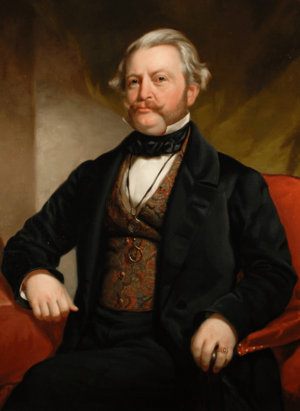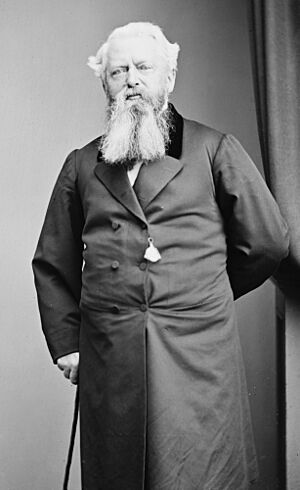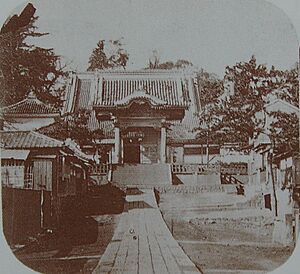Townsend Harris facts for kids
Quick facts for kids
Townsend Harris
|
|
|---|---|

Townsend Harris in 1855 (painted by James Bogle)
|
|
| Born | October 4, 1804 Washington County, New York, United States
|
| Died | February 25, 1878 (aged 73) |
| Signature | |
Townsend Harris (born October 4, 1804 – died February 25, 1878) was an American businessman and leader. He became the very first United States Consul General (a top diplomat) in Japan. He helped create the Harris Treaty between the US and Japan. Many people believe he was the diplomat who first opened up Shogunate Japan to trade and new ideas from other countries during the Edo period.
Contents
Early Life and Work in New York
Harris was born in a small village called Sandy Hill, which is now Hudson Falls. This was in upstate New York. He later moved to New York City. There, he became a very successful merchant, importing goods from places like China.
Helping New York's Schools
In 1846, Harris joined the New York City Board of Education. This group helps run the city's schools. He was even its president for two years. Harris loved to read and learn. He taught himself French, Italian, and Spanish.
He also started the Free Academy of the City of New York. This school later became the City College of New York. His goal was to offer education to working people in the city. A high school named after him, Townsend Harris High School, grew out of this academy. It closed for a while but was reopened in 1984. Today, it is a special public school for students interested in humanities.
Working with Siam (Now Thailand)
Before going to Japan, Harris first traveled to Bangkok, the capital of Siam. His job was to update an old treaty from 1833. He met with the Second King, Phra Pin Klao, who spoke English.
Harris explained America's goals:
The United States does not own any land in the East, nor does it want any. Our government does not allow us to have colonies. So, the United States cannot be a threat to any Eastern country. The President wants to create peaceful business relationships with Siam that help both sides. This is why I am here.
After some delays, he successfully updated the treaty. This new agreement was called the Harris Treaty of 1856. It gave Americans special extraterritorial rights. This meant Americans in Siam would follow American laws, not Siamese laws. An American missionary named Stephen Mattoon helped as a translator. He became the first US consul in Siam.
Opening Up Japan
In July 1856, President Franklin Pierce chose Harris to be the first Consul General to Tokugawa Japan. This happened soon after Commodore Matthew Perry had first opened trade with Japan in 1854. Harris opened the first US Consulate at the Gyokusen-ji Temple in Shimoda.
At that time, Japan was not united under one ruler. It was made up of many separate areas ruled by powerful lords. The old system of the Shogunate ended in 1868. This change happened partly because of Harris's work as a diplomat.
Working with Other Diplomats
Harris played a big role in Japan in the 1850s and 1860s. He worked with other Western diplomats like Dirk de Graeff van Polsbroek and Max von Brandt. Even though they were sometimes friends, their countries had rivalries. They also had different ideas about how to deal with the Japanese. But the difficult situation in Japan often made them work together.
Harris insisted on being treated with respect as a diplomat. He refused to give his president's letter to anyone but the Shogun himself in Edo (now Tokyo). After long talks that lasted 18 months, Harris finally met the Shogun in the palace. Four months later, he successfully negotiated the Treaty of Amity and Commerce. This treaty, also called the "Harris Treaty of 1858," opened up trade between the US and Japan. It also led to more Western influence in Japan.
Leaving Japan
Harris served during the first Japanese Embassy to the United States in 1860. He left Japan in 1861. When he left, a senior Japanese diplomat named Moriyama wrote to him: "You have been more than a friend. You have been our helper and teacher. Your spirit and memory will live forever in the history of Japan."
Harris was very impressed by Japan. He wrote:
"The people all appeared clean and well-fed... well clothed and happy looking. It is more like the golden age of simplicity and honesty than I have ever seen in any other country."
Back in the United States
Townsend Harris returned to New York in 1861. He had spent five very important and successful years as a diplomat in Japan.
Years later, in 1874, Harris met with author William Elliot Griffis in New York. Griffis had lived in Japan from 1871 to 1874, helping to modernize their education system. Harris asked Griffis, "What do the Japanese think of me?" Harris had not published his journals from his time in Japan. Griffis felt that Harris did not fully understand how much good he had done in Japan.
In 1893, Griffis got Harris's journals from Harris's niece. He had them published in 1895 as a book called Townsend Harris, First American Envoy in Japan. This book was even translated into Japanese. It became the basis for a play about Harris, written by Kido Okamoto, which was very popular in Japan in 1919. This showed how much the Japanese people respected Harris.
Death and Lasting Impact
Harris passed away in New York City on February 25, 1878, at 73 years old. He is buried in Green-Wood Cemetery in Brooklyn, New York.
In 1986, the nation of Japan gave a special gift. They helped fix up Harris's gravesite. They added new paving stones, a stone lantern, and trees like a cherry tree and a dogwood tree. They also placed two special stones to remember him. This gift showed the continued respect and affection the Japanese people have for Townsend Harris.
Townsend Harris in Movies
Harris was played by famous actor John Wayne in the 1958 movie The Barbarian and the Geisha. The movie was directed by John Huston. The main story about Harris trying to make peace between the US and Japan is mostly true. However, the part about a love story between Harris and a woman named Okichi is mostly made up for the movie.
See also
- Hotta Masayoshi
- List of Westerners who visited Japan before 1868
- Sakoku




